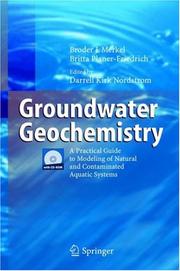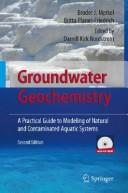| Listing 1 - 3 of 3 |
Sort by
|

ISBN: 3540272216 3540241957 Year: 2005 Publisher: Berlin, Heidelberg : Springer Berlin Heidelberg : Imprint: Springer,
Abstract | Keywords | Export | Availability | Bookmark
 Loading...
Loading...Choose an application
- Reference Manager
- EndNote
- RefWorks (Direct export to RefWorks)
To understand hydrochemistry and to analyze natural as well as man-made impacts on aquatic systems, hydrogeochemical models have been used since the 1960’s and more frequently in recent times. Numerical groundwater flow, transport, and geochemical models are important tools besides classical deterministic and analytical approaches. Solving complex linear or non-linear systems of equations, commonly with hundreds of unknown parameters, is a routine task for a PC. Modeling hydrogeochemical processes requires a detailed and accurate water analysis, as well as thermodynamic and kinetic data as input. Thermodynamic data, such as complex formation constants and solubility products, are often provided as data sets within the respective programs. However, the description of surface-controlled reactions (sorption, cation exchange, surface complexation) and kinetically controlled reactions requires additional input data. Unlike groundwater flow and transport models, thermodynamic models, in principal, do not need any calibration. However, considering surface-controlled or kinetically controlled reaction models might be subject to calibration. Typical problems for the application of geochemical models are: speciation determination of saturation indices adjustment of equilibria/disequilibria for minerals or gases mixing of different waters modeling the effects of temperature stoichiometric reactions (e.g. titration) reactions with solids, fluids, and gaseous phases (in open and closed systems) sorption (cation exchange, surface complexation) inverse modeling kinetically controlled reactions reactive transport Hydrogeochemical models are dependent on the quality of the chemical analyses, the boundary conditions presumed by the program, theoretical concepts (e.g.
Water chemistry --- Mathematical models. --- Aquatic chemistry --- Chemical hydrology --- Hydrochemistry --- Hydrogeochemistry --- Natural water chemistry --- Geochemistry --- Hydrology --- Hydraulic engineering. --- Geology. --- Analytical biochemistry. --- Geography. --- Hydrogeology. --- Water Quality/Water Pollution. --- Analytical Chemistry. --- Geotechnical Engineering & Applied Earth Sciences. --- Earth Sciences, general. --- Cosmography --- Earth sciences --- World history --- Analytic biochemistry --- Biochemistry --- Chemistry, Analytic --- Geognosy --- Geoscience --- Natural history --- Engineering, Hydraulic --- Engineering --- Fluid mechanics --- Hydraulics --- Shore protection --- Bioanalytic chemistry --- Bioanalytical chemistry --- Analytical chemistry --- Water quality. --- Water pollution. --- Analytical chemistry. --- Geotechnical engineering. --- Earth sciences. --- Geosciences --- Environmental sciences --- Physical sciences --- Engineering, Geotechnical --- Geotechnics --- Geotechnology --- Engineering geology --- Analysis, Chemical --- Analytic chemistry --- Chemical analysis --- Chemistry --- Aquatic pollution --- Fresh water --- Fresh water pollution --- Freshwater pollution --- Inland water pollution --- Lake pollution --- Lakes --- Reservoirs --- River pollution --- Rivers --- Stream pollution --- Water contamination --- Water pollutants --- Water pollution --- Pollution --- Waste disposal in rivers, lakes, etc. --- Freshwater --- Freshwater quality --- Marine water quality --- Quality of water --- Seawater --- Seawater quality --- Water --- Environmental quality --- Geohydrology --- Geology --- Groundwater --- Quality --- Composition --- Pollution.

ISBN: 3540746684 3540746676 9783540746676 9783540746683 Year: 2008 Publisher: Berlin, Heidelberg : Springer Berlin Heidelberg : Imprint: Springer,
Abstract | Keywords | Export | Availability | Bookmark
 Loading...
Loading...Choose an application
- Reference Manager
- EndNote
- RefWorks (Direct export to RefWorks)
To understand hydrochemistry and to analyze natural as well as man-made impacts on aquatic systems, hydrogeochemical models have been used since the 1960’s and more frequently in recent times. Numerical groundwater flow, transport, and geochemical models are important tools besides classical deterministic and analytical approaches. Solving complex linear or non-linear systems of equations, commonly with hundreds of unknown parameters, is a routine task for a PC. Modeling hydrogeochemical processes requires a detailed and accurate water analysis, as well as thermodynamic and kinetic data as input. Thermodynamic data, such as complex formation constants and solubility-products, are often provided as databases within the respective programs. However, the description of surface-controlled reactions (sorption, cation exchange, surface complexation) and kinetically controlled reactions requires additional input data. Unlike groundwater flow and transport models, thermodynamic models, in principal, do not need any calibration. However, considering surface-controlled or kinetically controlled reaction models might be subject to calibration. Typical problems for the application of geochemical models are: • speciation • determination of saturation indices • adjustment of equilibria/disequilibria for minerals or gases • mixing of different waters • modeling the effects of temperature • stoichiometric reactions (e.g. titration) • reactions with solids, fluids, and gaseous phases (in open and closed systems) • sorption (cation exchange, surface complexation) • inverse modeling • kinetically controlled reactions • reactive transport Hydrogeochemical models depend on the quality of the chemical analysis, the boundary conditions presumed by the program, theoretical concepts (e.g.
Water chemistry --- Mathematical models. --- Aquatic chemistry --- Chemical hydrology --- Hydrochemistry --- Hydrogeochemistry --- Natural water chemistry --- Geochemistry --- Hydrology --- Hydraulic engineering. --- Analytical biochemistry. --- Geography. --- Environmental toxicology. --- Hydrogeology. --- Hydrology/Water Resources. --- Analytical Chemistry. --- Geotechnical Engineering & Applied Earth Sciences. --- Earth Sciences, general. --- Ecotoxicology. --- Ecotoxicology --- Pollutants --- Pollution --- Environmental health --- Toxicology --- Cosmography --- Earth sciences --- World history --- Analytic biochemistry --- Biochemistry --- Chemistry, Analytic --- Engineering, Hydraulic --- Engineering --- Fluid mechanics --- Hydraulics --- Shore protection --- Bioanalytic chemistry --- Bioanalytical chemistry --- Analytical chemistry --- Hydrology. --- Analytical chemistry. --- Geotechnical engineering. --- Earth sciences. --- Geosciences --- Environmental sciences --- Physical sciences --- Engineering, Geotechnical --- Geotechnics --- Geotechnology --- Engineering geology --- Analysis, Chemical --- Analytic chemistry --- Chemical analysis --- Chemistry --- Aquatic sciences --- Hydrography --- Water --- Geohydrology --- Geology --- Groundwater --- Water chemistry - Mathematical models
Book

ISBN: 3763966269 3763960546 9783763966264 9783763960545 Year: 2021 Publisher: Bielefeld wbv Publikation
Abstract | Keywords | Export | Availability | Bookmark
 Loading...
Loading...Choose an application
- Reference Manager
- EndNote
- RefWorks (Direct export to RefWorks)
Digitalisierung ist auch in den Humandienstleistungsberufen eine Kraft, die viel verändert. Der Sammelband zeichnet ein detailliertes Bild der Probleme und Aufgaben für die berufliche sowie akademische Aus- und Weiterbildung in den Care-Berufen. Die Beiträge des Bandes zeichnen ein facettenreiches Bild zum Status quo der Digitalisierung in der Aus- und Weiterbildung in den Berufsfeldern Gesundheit, Pflege, Altenpflege, Ernährung und Hauswirtschaft sowie Soziale Arbeit und Sozialpädagogik. Themen sind systematische, strukturelle und empirische Perspektiven auf die Berufsbildung in Care-Berufen, berufs- und hochschuldidaktische Analysen und die Professionalisierung des Bildungspersonals in Zusammenhang mit digitalen Entwicklungen und Möglichkeiten. Das interdisziplinäre Autorenteam aus der Arbeits-, Sozial- und Berufswissenschaft eröffnet differenzierte Einblicke in die Entwicklungen der Digitalisierung in der beruflichen Bildung und Berufspädagogik des Care-Sektors.
Education / Vocational --- Education --- Children --- Education, Primitive --- Education of children --- Human resource development --- Instruction --- Pedagogy --- Schooling --- Students --- Youth --- Civilization --- Learning and scholarship --- Mental discipline --- Schools --- Teaching --- Training --- Berufsbildung --- Lehrerbildung --- soziale Arbeit --- Gesundheits- und Krankenpflege --- Hauswirtschaft --- Berufsschullehrerbildung --- Arbeit 4.0 --- Digitale Kompetenzen --- Ernährung --- personenbezogene Dienstleistungsberufe --- Humandienstleistungsberufe --- wbv OpenLibrary 2020
| Listing 1 - 3 of 3 |
Sort by
|

 Search
Search Feedback
Feedback About UniCat
About UniCat  Help
Help News
News